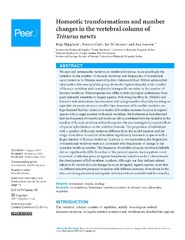Приказ основних података о документу
Homeotic transformations and number changes in the vertebral column of Triturus newts
| dc.creator | Ajduković, Maja | |
| dc.creator | Galis, Frietson | |
| dc.creator | Arntzen, Jan W. | |
| dc.creator | Ivanovic, Ana | |
| dc.date.accessioned | 2016-05-23T11:00:54Z | |
| dc.date.issued | 2015 | |
| dc.identifier.issn | 2167-8359 | |
| dc.identifier.uri | https://radar.ibiss.bg.ac.rs/handle/123456789/2337 | |
| dc.description.abstract | We explored intraspecific variation in vertebral formulae, more specifically the variation in the number of thoracic vertebrae and frequencies of transitional sacral vertebrae in Triturus newts (Caudata: Salamandridae). Within salamandrid salamanders this monophyletic group shows the highest disparity in the number of thoracic vertebrae and considerable intraspecific variation in the number of thoracic vertebrae. Triturus species also differ in their ecological preferences, from predominantly terrestrial to largely aquatic. Following Geoffroy St. Hilaire's and Darwin's rule which states that structures with a large number of serially homologous repetitive elements are more variable than structures with smaller numbers, we hypothesized that the variation in vertebral formulae increases in more elongated species with a larger number of thoracic vertebrae. We furthermore hypothesized that the frequency of transitional vertebrae will be correlated with the variation in the number of thoracic vertebrae within the species. We also investigated potential effects of species hybridization on the vertebral formula. The proportion of individuals with a number of thoracic vertebrae different from the modal number and the range of variation in number of vertebrae significantly increased in species with a larger number of thoracic vertebrae. Contrary to our expectation, the frequencies of transitional vertebrae were not correlated with frequencies of change in the complete vertebrae number. The frequency of transitional sacral vertebra in hybrids did not significantly differ from that of the parental species. Such a pattern could be a result of selection pressure against transitional vertebrae and/or a bias towards the development of full vertebrae numbers. Although our data indicate relaxed selection for vertebral count changes in more elongated, aquatic species, more data on different selective pressures in species with different numbers of vertebrae in the two contrasting, terrestrial and aquatic environments are needed to test for causality. | en |
| dc.description.sponsorship | Serbian Ministry of Education and Science {[}173043]; SyntheSys {[}NL-TAF 1245, NL-TAF 3082]; Naturalis Biodiversity Center `Temminck fellowship' | |
| dc.language | English | |
| dc.rights | openAccess | |
| dc.rights.uri | https://creativecommons.org/licenses/by/4.0/ | |
| dc.source | Peerj | |
| dc.subject | Axial skeleton | |
| dc.subject | Transitional vertebrae | |
| dc.subject | Geoffroy St. Hilaire's rule | |
| dc.subject | Salamaders | |
| dc.subject | Amphibia | |
| dc.title | Homeotic transformations and number changes in the vertebral column of Triturus newts | en |
| dc.type | article | |
| dc.rights.license | BY | |
| dcterms.abstract | Галис, Фриетсон; Слијепцевиц, Маја; Ивановиц, Aна; Aрнтзен, Јан W.; | |
| dc.rights.holder | © 2015 Slijepčević et al. | |
| dc.citation.issue | e1397 | |
| dc.citation.volume | 3 | |
| dc.identifier.doi | 10.7717/peerj.1397 | |
| dc.identifier.scopus | 2-s2.0-84949682101 | |
| dc.identifier.wos | 000365803100009 | |
| dc.type.version | publishedVersion | en |
| dc.identifier.fulltext | https://radar.ibiss.bg.ac.rs/bitstream/id/6083/peerj-1397.pdf | |
| dc.citation.rank | M21 |

